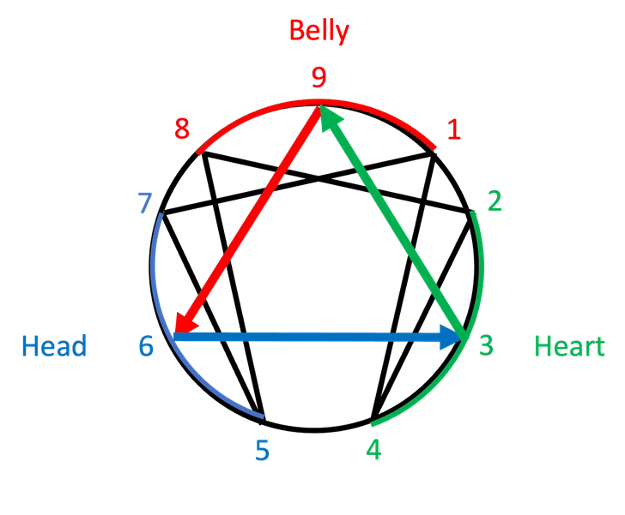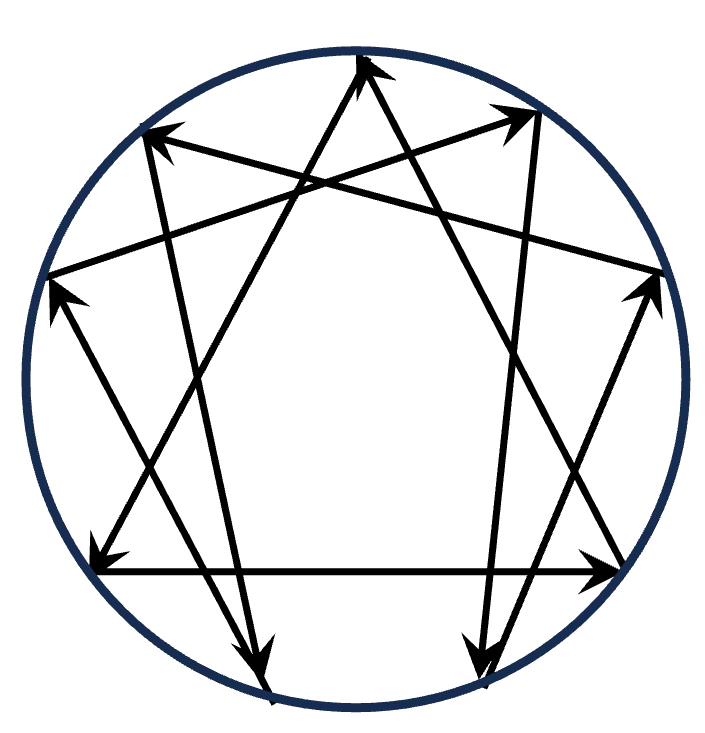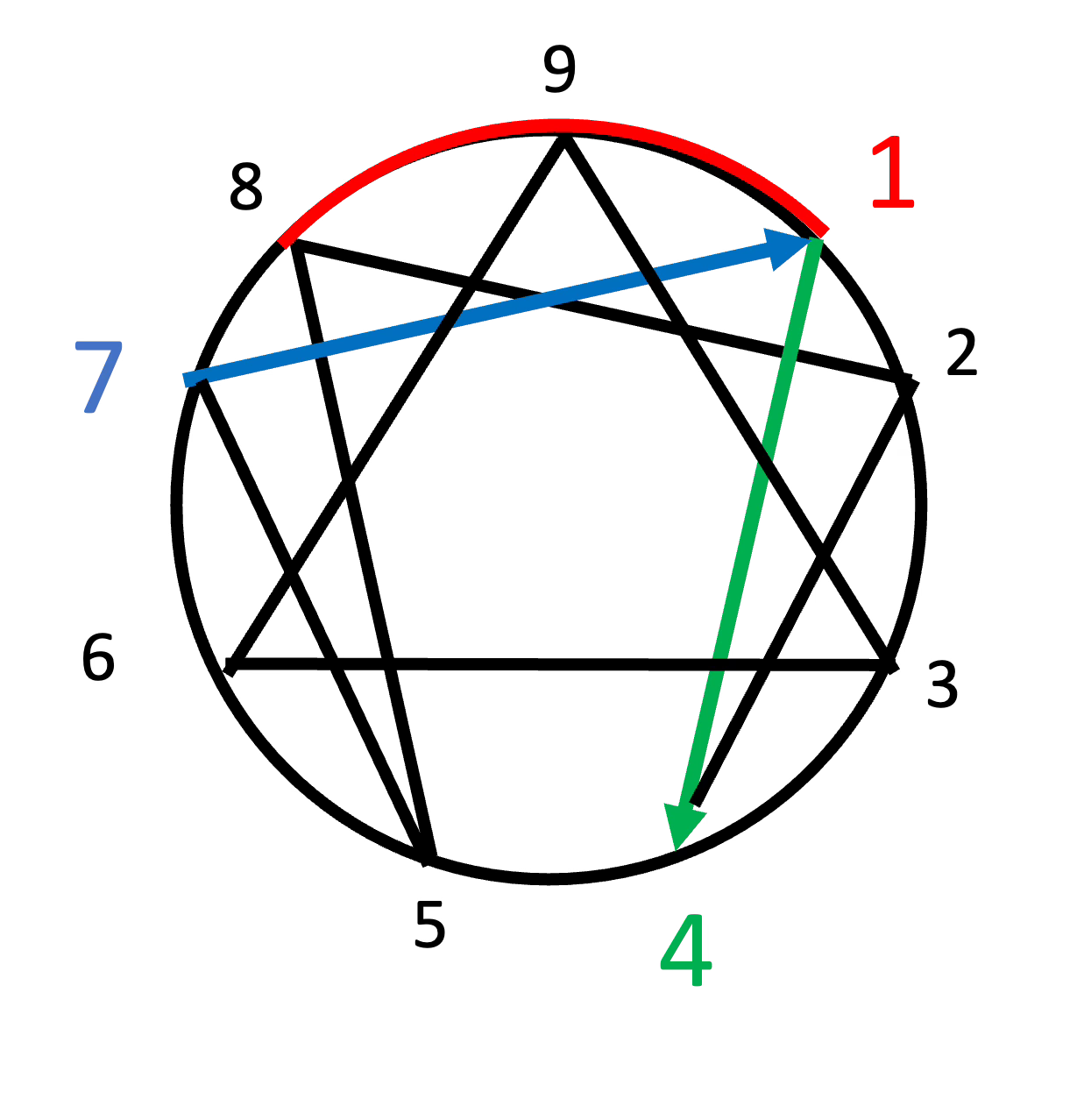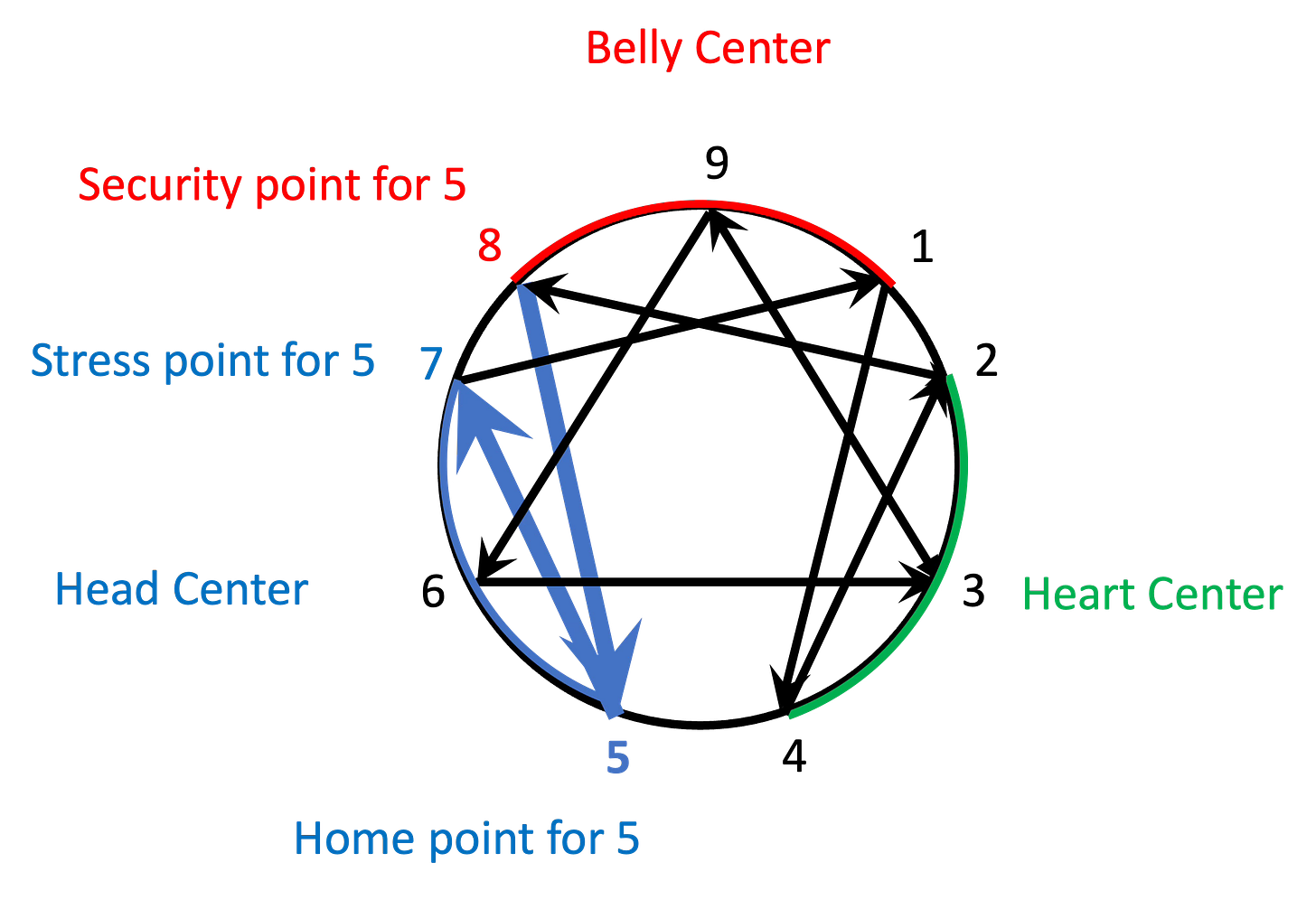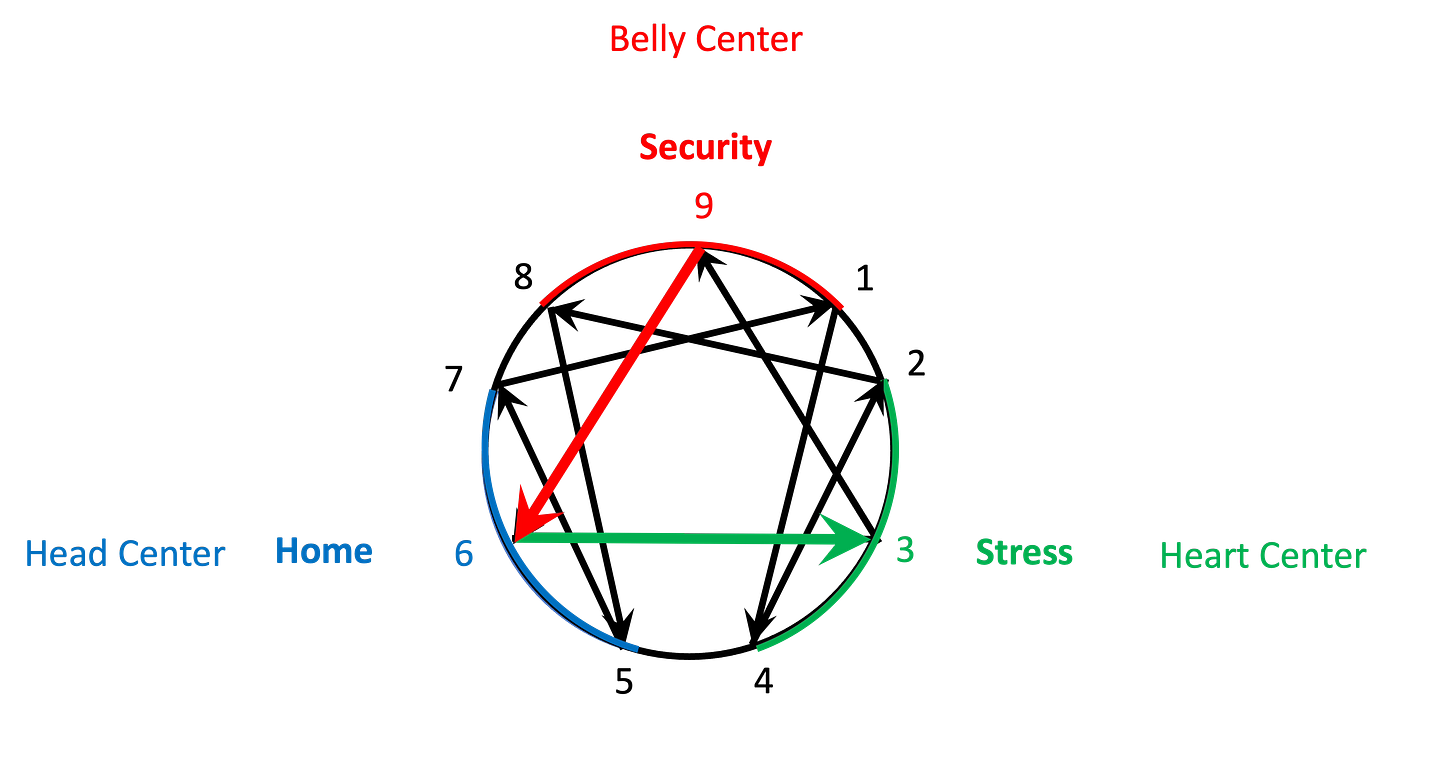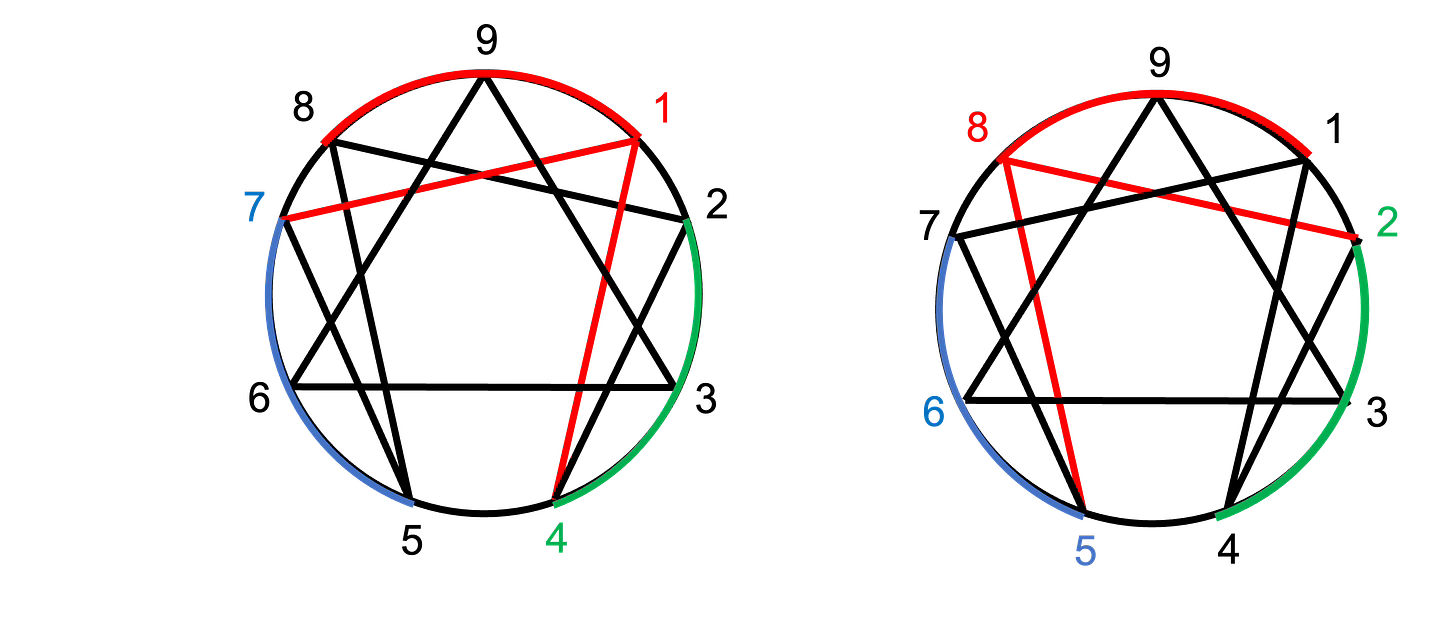Patterns of Movement
One of the most important constructs of the Enneagram centers typologies is what I am calling “patterns of movement”.
The patterns of movement construct in these typologies derives from the Enneagram symbol. The Enneagram symbol depicts a triangle inscribed within a circle, with nine points distributed equally around the circle. Each point is connected by lines to two other points on the circle. Each line has an arrow at one end.
The points on the circle are numbered 1 - 9, beginning with 9 at the top. The flow of the arrows connecting the three points of the triangle is 9 → 3 → 6, and then back to 9 again. The flow of the arrows connecting the other points on the circle is 1 → 4 → 2 → 8 → 5→ 7, and then back to 1 again.
Understanding “Patterns of Movement” as a construct of the Enneagram typology
This pattern of flow around the two shapes that comprise the Enneagram symbol gives the Enneagram a unique characteristic in terms of personality typologies. These patterns of flow around the symbol have traditionally been interpreted as a depiction of how thoughts, feelings, and behaviors of each type shift in response to changing situations. Using type 1 as an example, the arrow pointing from type 7 towards type 1 indicates that type 1 will think, feel, and act more like type 7 in certain situations, while the arrow pointing away from type 1 towards type 4 means that type 1 will think, feel, and act more like a type 4 in other situations.
Stress and Security Points
Most contemporary Enneagram typologies describe the patterns of movement in the Enneagram typology in terms of stress and security points. For example, Palmer explains that in her model, each type is conceptualized as being a compilation of three types: the home point and the two points connected by the lines and arrows on the symbol: “… each personality type is composed of three aspects: the predominating aspect, which is operative under usual conditions, which is called your type; the aspect that operates when you go into action (or are placed under stress); and the aspect that comes into play in secure (non-stressful) situations…. Thus each type is really a union of three aspects, each of which is likely to be stimulated by particular life situations. For example, when an Observer (usually quiet and withdrawn) is under stress, she or he moves to the position of the Epicure (paradoxically more outgoing and friendly in an effort to reduce stress by making contact with people). When she or he is secure, the Observer tends to become a Boss (directive of others and controlling of personal space)”.1
Nine unique patterns of movement within and between the centers.
As depicted on the Enneagram symbol, each type has its own unique pattern of movement.
The Core Types
Types 3, 6, and 9 are located in the middle of each center and are connected to each other by the triangle inscribed in the circle of the symbol. Because of their location in the middle each center, types 3, 6, and 9 are referred to as the core types. Type 9, the core of the Belly center, has a direct connection to the core of the Heart center at type 3 and the core of the Head center at type 6. Type 3, the core of the Heart center, has a direct connection to the core of the Belly center at type 9 and the core of the Head center at type 6. Type 6, the core of the Head center, has a direct connection to the core of the Belly center at type 9 and the core of the Heart center at type 3.
Following the pattern created by the direction of the arrows on the connecting lines of the triangle, type 9 looks like type 3 in security and type 6 in stress:
Type 3 looks like type 6 in security and type 9 in stress:
And type 6 looks like type 9 in security and type in stress:
Types 8 and 1
Types 8 and 1 are located on either side of type 9. Types 8, 9, and 1 share a common structure as Belly types, but the structures of 8 and 1 are oriented more towards one side or the other of the Enneagram symbol. Type 1 leans to the right, or Heart side, of the symbol and connects to the Heart center at type 4 and the Head center at type 7. Type 8 leans to the left, or Head side of the symbol and connects to the Head center at type 5 and the Heart center at type 2.
Type 1 looks like type 4 in stress and type 7 in security; type 8 looks like type 5 in stress and type 2 in security.
Types 2, 4, 5, and 7
The three core types (3, 6, and 9) and the two none-core Belly type (8 and 1) each have direct connections to all three centers. In contrast, types 2 and 4 in the Heart center and types 5 and 7 in the Head center have direct connections to only two of the three centers. Instead of having direct connections to all three centers, these types have one direct connection to another center and one direct connection to the other non-core type in their home center.
On the right side of the symbol, types 2 and 4 both have direct connections to the Belly center and direct connections to the other non-core type of the Heart center.
Type 2 has a direct connection to the Belly center at type 8 and a direct connection within the Heart center at type 4. Type 4 has a direct connection to the Belly center at type 1 and a direct connection within the Heart center at type 2.
Type 2 looks like type 4 in security and type 8 in stress; type 4 looks like type 1 in security and type 2 in stress.
On the left side of the symbol, types 5 and 7 both have direct connections to the Belly center and direct connections to the other non-core type of the Head center.
Type 5 looks like type 8 in security and type 7 in stress; type 7 looks like type 5 in security and type 1 in stress.
Summary
The Enneagram symbol depicts a circle inscribed by a triangle. Nine points are distributed equally around the circle and each point is connected by arrowed lines to two other points on the circle.
The arrows on symbol depict two patterns of flow around the symbol. The arrows on the triangle shape of the symbol depict a 3 → 9 → 6 pattern. The arrows on the circle shape of the symbol depict a 1 → 4 → 2 → 8 → 5 → 7 pattern.
These patterns have traditionally been understood to reflect how each time changes in terms of thoughts, feelings, and behaviors under different circumstances.
Palmer, H. (1988). The Enneagram: Understanding yourself and others in your life. HarperCollins, p. 43.

